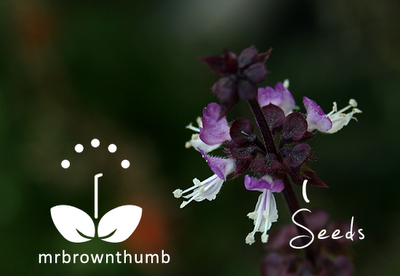How To Collect Basil Seeds
Of all the edible plants people can grow in their gardens, or in containers, basil has to be the easiest of them all. No herb garden is complete without at least one basil plant growing. My only problem with growing basil is the price of basil seedlings and seeds of the nicer basil cultivars available. Growing basil from seeds is very easy and the most affordable way to grow many basil plants. Once you've grown a basil plant saving seeds from your basil plant is very easy, you just need to learn where to look on the plant so you know how to collect basil seeds.
The blooms of Thai basil 'Queenette' that I grew from seeds from ReneesGarden. A nice aromatic basil with deep purple stems, purple flowers and narrow leaves. What does this Thai basil taste and smell like? A lot like black licorice, if you ask me. I'm not a fan of black licorice but I really liked this basil.
Basil blooms grow in a grouping around the stems of the plants. Basil flowers attract beneficial insects into the garden and are pollinated by bees. After the bees have pollinated the flowers the petals and reproductive parts of the plants fall off. The part of the flower that remains is where the seeds will develop and from where you'll collect them. Unfortunately, basil plants don't produce seed "pods" or very large seeds, which makes saving basil seeds a bit of a challenge for a new seed-saving gardener. I've marked the basil flower picture above with the location of where the seeds will develop.
Usually, if you wait for a stem or seed pod to turn brown you know that it is safe to harvest the seeds. With basil seeds a mature seed can sit next to seeds that haven't ripened yet. If you look at the underside of a flowering basil stem, you'll be able to look up and see the developing basil seeds. See the black spots along the stem? Those are the basil seeds that are ready to be picked.
Inside each of these seed "pods" are two pairs of small black seeds. Basil seeds that are light-colored are seeds that haven't matured.
If you want to be very meticulous about saving basil seeds you can pluck each of these pods off individually collecting only the black seeds, because mature and immature seeds develop alongside each other. Take a look at the basil seeds in the picture above.
If you don't mind losing a few seeds: the easiest way to collect basil seeds is to allow the stems of the plants to turn brown and storing (and drying) the basil seeds inside a paper bag. Any basil seeds that fall out are caught inside the bag. Harvesting the basil seeds from among all the chaff can be a little time consuming because there will be a lot of chaff this way. Give the bag a sold shake every once in a while to help dislodge the seeds and allow them to fall into the bag. Now that you've harvest basil seeds from your plants, you can use the seeds to expand your herb garden or share them with friends.
Related: Growing 'Windowbox' Basil.
The blooms of Thai basil 'Queenette' that I grew from seeds from ReneesGarden. A nice aromatic basil with deep purple stems, purple flowers and narrow leaves. What does this Thai basil taste and smell like? A lot like black licorice, if you ask me. I'm not a fan of black licorice but I really liked this basil.
Basil blooms grow in a grouping around the stems of the plants. Basil flowers attract beneficial insects into the garden and are pollinated by bees. After the bees have pollinated the flowers the petals and reproductive parts of the plants fall off. The part of the flower that remains is where the seeds will develop and from where you'll collect them. Unfortunately, basil plants don't produce seed "pods" or very large seeds, which makes saving basil seeds a bit of a challenge for a new seed-saving gardener. I've marked the basil flower picture above with the location of where the seeds will develop.
Usually, if you wait for a stem or seed pod to turn brown you know that it is safe to harvest the seeds. With basil seeds a mature seed can sit next to seeds that haven't ripened yet. If you look at the underside of a flowering basil stem, you'll be able to look up and see the developing basil seeds. See the black spots along the stem? Those are the basil seeds that are ready to be picked.
Inside each of these seed "pods" are two pairs of small black seeds. Basil seeds that are light-colored are seeds that haven't matured.
If you want to be very meticulous about saving basil seeds you can pluck each of these pods off individually collecting only the black seeds, because mature and immature seeds develop alongside each other. Take a look at the basil seeds in the picture above.
If you don't mind losing a few seeds: the easiest way to collect basil seeds is to allow the stems of the plants to turn brown and storing (and drying) the basil seeds inside a paper bag. Any basil seeds that fall out are caught inside the bag. Harvesting the basil seeds from among all the chaff can be a little time consuming because there will be a lot of chaff this way. Give the bag a sold shake every once in a while to help dislodge the seeds and allow them to fall into the bag. Now that you've harvest basil seeds from your plants, you can use the seeds to expand your herb garden or share them with friends.
Related: Growing 'Windowbox' Basil.






0 Response to "How To Collect Basil Seeds"
Post a Comment